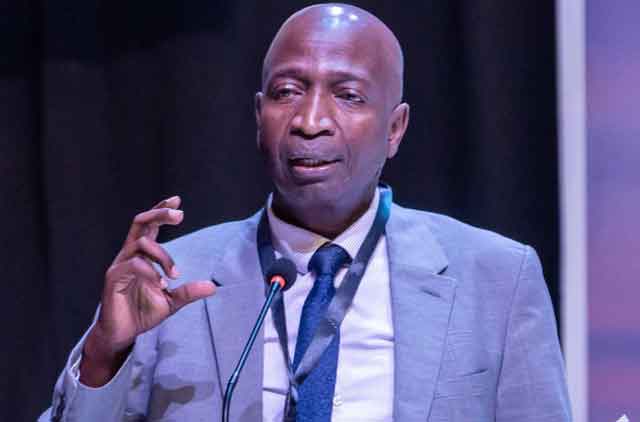
Beehive of activity expected says PAU boss Rubondo
Kampala, Uganda | RONALD MUSOKE | The level of investments in Uganda’s oil and gas project is exciting, says Ernest Rubondo, the executive director of the Petroleum Authority of Uganda (PAU).
And in 2022, Rubondo says, the government expects close to Shs11 trillion (US$3bn) worth of investments into the sector. This as TotalEnergies and the China National Offshore Oil Corporation (CNOOC); the two international companies tasked with commercializing the country’s petroleum resources, ramp up activities to build and operate three flagship projects.
The projects include;Tilenga operated by TotalEnergies in Buliisa and Nwoya Districts valued at US$4 billion and the Kingfisher project operated by CNOOC in Hoima and Kikuube Districts valued at US$ 1.5 billion. These two projects are expected to produce a combined 230,000 barrels of crude oil per day at plateau. The third main project is the East African Crude Oil Pipeline (EACOP) from Uganda to Tanzania valued at a cost of about US$3.5billion.
“With this momentum, 2022 is going to see a beehive of activity for the oil and gas sector, the Ugandan economy, and the region at large,” Rubondo said, “The year 2022 is going to commence the period of three years of intense infrastructure development in preparation for first oil in 2025.”
Rubondo says more oil dollars, as much as US$ 15 billion (Approx. Shs56 trillion), will get into the Ugandan economy over the next three years. He was briefing journalists on Jan.11 at Amber House in Kampala where the Ministry of Energy and Mineral Development headquarters are located on key milestones registered in Uganda’s oil and gas industry since 2020.
He said Uganda’s oil projects remain economically viable in the prevailing crude oil price environment. This is mainly driven by the low cost of finding and developing the resources in Uganda. The PAU estimates that the current project technical costs are below US$ 20 per barrel and the break-even cost, at a 15% discount rate, is below US$ 35 per barrel, Rubondo said.
In terms of macro-economic benefits, the GDP of Uganda, which was estimated at over US$37bn in the FY 2020/21, is expected to be significantly enhanced by the massive investments anticipated in the sector and through the linkages between oil and gas and other sectors of the economy like agriculture, tourism, manufacturing, and transport, among others.
The benefits which are expected to accrue to the economy as a result of harnessing these linkages are estimated to increase the country’s current GDP by 22% in the next 3-4 years of the construction phase.
Rubondo said Uganda’s oil and gas sector has progressed “very successfully” over the last two years—a period that saw economies across the world grounded due to the COVID-19 pandemic.
He noted that the onset of the COVID-19 pandemic did not hold back the progress of Uganda’s oil and gas sector and signing the final oil agreements and subsequent launch of the oil and gas projects on April 11 last year, was the highlight.
Big investments
To put the expected investments in perspective, Rubondo compared them with the cost of hosting the FIFA Soccer World Cup and the Summer Olympic Games—two of the world’s most prestigious sporting events.
Normally, Rubondo said, hosting countries invest anywhere between US$2-6 billion to construct facilities to successfully host the sporting jamboree. But, he said, that pales in comparison to the US$15 billion Uganda expects to get in the oil industry over the next three years.
He said when you factor in the preparatory investments into infrastructure projects like the Kabaale International Airport and the hundreds of kilometres of oil roads which are both valued at US$ 2bn, the investment value is better.
“The anticipated infrastructural improvements for a developing country like Uganda will go a long way to improve trade and other economic activities in the host communities and surrounding areas,” he said.
He said even when the world has been wobbling thanks to the effects of the ongoing COVID-19 pandemic, investments into the local oil industry never stopped.
In 2019, Uganda registered about Shs 862 billion (US$230 million) worth of investments in the sector while in 2020—the year the pandemic hit Uganda— the investments shrunk, but only to about Shs675 billion (US$ 180 million). However, they rose again last year to about Shs1.87 trillion (US$500 million).
“Many more Ugandans are now directly and indirectly employed in the country’s oil and gas sector,” he said, adding that, “Ugandans and Ugandan enterprises are also taking up the big and lucrative opportunities to provide goods and services.”

Following the launch of the oil projects in April 2021, the licensed oil companies; TotalEnergies and China National Offshore Oil Corporation (CNOOC) have concluded the procurement process and are now dishing out contracts for their flagship projects.
The Tilenga project’s main Engineering Procurement Supply Construction and Commissioning (EPSCC) contract were, for instance, awarded to the consortium of McDermott and Sinopec. These two have since commenced work and are currently taking forward detailed engineering and other activities in London, Beijing and Gurugram in India.
Ten other contracts for drilling and management of wells for the Tilenga Project have also been issued. ZPEB Uganda Company Limited which won the contract for the detailed design and construction of the drilling rigs is already working on its assignment. The rigs are to be used in drilling up to 426 wells, scheduled to commence in the last quarter of 2022.
The contract for civil works to prepare over 700 acres of industrial area for the Tilenga project was awarded to Mota Engil Uganda. These works include bush clearing, fencing, construction of drainage and internal roads and preparation of the ground to host different facilities.
The facilities to be hosted in this industrial area include the Central Processing facility (CPF), construction camps, drilling support bases, and operation support bases, among others. Mota Engil Uganda has sub-contracted various Uganda companies; including Gauff Consultants, Prand Engineering, Civtec, Fabrication Systems among others, to undertake some of these works. Preparation of the Tilenga industrial site was at 35% completion at the end of 2021 and is expected to be concluded by mid-2022.
Meanwhile, the contract for construction of pads on which the wells for the Tilenga project will be drilled was also awarded to MotaEngil Uganda Ltd. This contract includes preparation of 31 well pad sites, installation of conductor pipes and construction of well cellars among others.
The work is expected to commence in the first quarter of 2022, in preparation for the commencement of development drilling in the last quarter of 2022.
A contract for civil works and construction of well pads 1, 2 and 3 for the Kingfisher project together with construction of in-field access roads was awarded to Excel Construction Limited, another Ugandan company.
A contract to design and construct Kingfisher Project EPC-2 infrastructure facilities was awarded to China State Construction Engineering Corporation Ltd (CSCEC). Additional contracts for the Kingfisher project, including drilling and well services are due to be awarded during 2022.
Local suppliers
Rubondo noted that the scope of companies being regulated by PAU is increasing significantly as it now includes the licensed oil companies, their contractors and sub-contractors at the different levels.
Up to 92% of the supply of goods and services to the country’s oil and gas sector in 2020 were by Ugandan entities while in 2021, 53% of the supplies and services were from Uganda entities.
Some of the services provided by Ugandan companies include human resource services, construction, agricultural and crop development, environmental and waste management services, broadcasting services, housing, hotel accommodation and office rental services, security services, ICT accessories and services, education management services, insurance, vehicle hire, tracking and maintenance, medical services and equipment, and legal services.
Rubondo noted that up to 330 Ugandan entities that have provided goods and services to the oil and gas activities between 2017 and 2020. They have provided goods and services worth over U$1bn out of the total investment into the sector of US$ 3.7billion as at the end of 2021.
On the National Supplier Database which is a register of all entities with interest to supply goods, works and services to the oil and gas sector, there are now 2,662 companies qualified and registered by the PAU. This is almost five times the number that was on the registry in 2017 when it was launched.
Rubondo said 1,966 companies on the registry are Ugandan entities while the rest are companies from 48 countries. This implies an increase in investment in the country, but also the opportunities for local entrepreneurs and high-level employment of skilled Ugandans.
But Don Bwesigye Binyina, the executive director of the African Centre for Energy and Mineral Policy (ACEMP), a Kampala-based non-profit, told The Independent on Jan.14 that these are indeed good investments but the government ought to temper its expectations.
“It looks like good money on paper but is it the best we could have got had government not dithered a few years back?”he said.
Binyina told The Independent that it is also good the oil companies are employing Ugandans but this should not be interpreted only in terms of numbers but the quality of employment should also be looked at critically. He also hopes the remuneration will match the internationally competitive rates that the oil industry is renowned for.
Dickens Kamugisha, the executive director of the African Institute for Energy Governance (AFIEGO), a Kampala-based civil society organisation that advocates for responsible investment in Uganda’s oil and gas sector, said he is unconvinced by the government’s rosy picture of the oil and gas industry.
“Yes, the money is going to come in but even Nigeria with the biggest economy and large oil investments has some of the poorest people on the continent. This is something the government must try to avoid repeating in Uganda,” Kamugisha told The Independent.
****
 The Independent Uganda: You get the Truth we Pay the Price
The Independent Uganda: You get the Truth we Pay the Price



